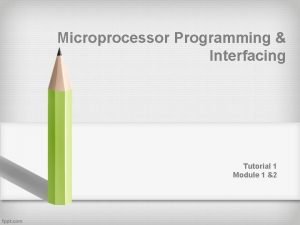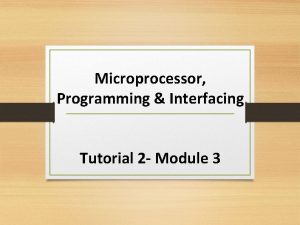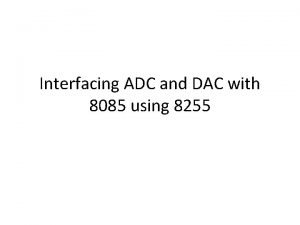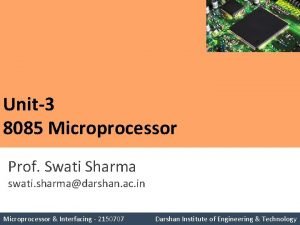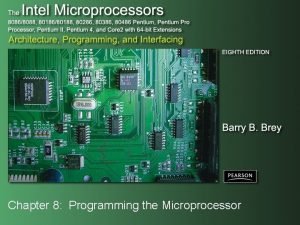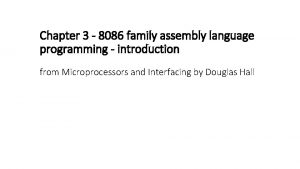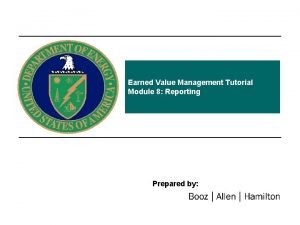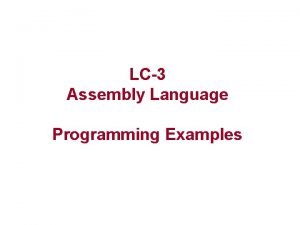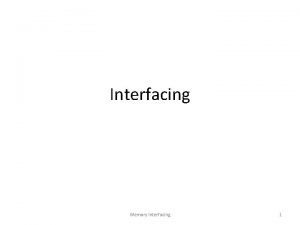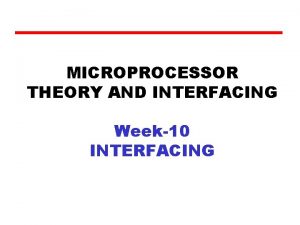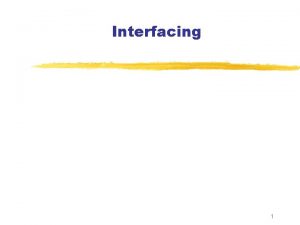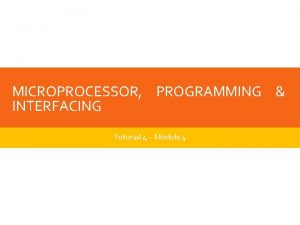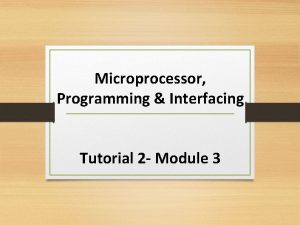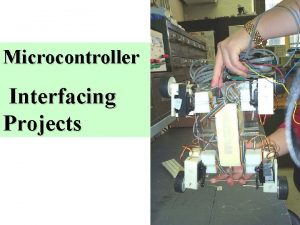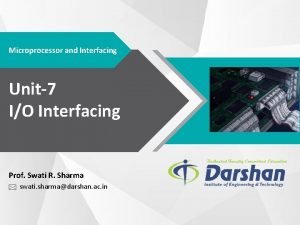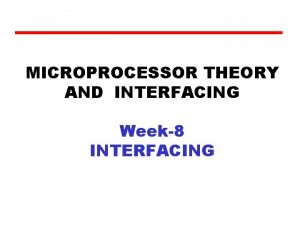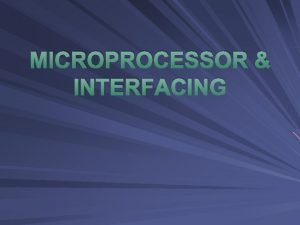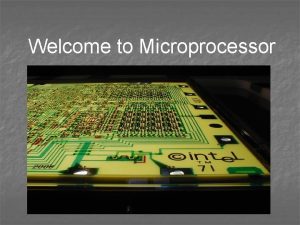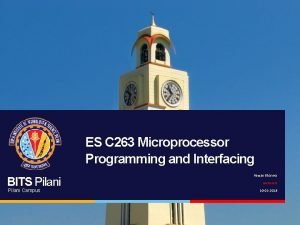Microprocessor Programming Interfacing Tutorial 1 Module 1 2














- Slides: 14

Microprocessor Programming & Interfacing Tutorial 1 Module 1 &2

Question 1 • What will be the result and what will be the nature of the result in terms (All operations should be done using signmagnitude form of representation) – – – is the result zero? is there a carry is there an auxiliary carry? is the result negative? is there an two’s complement overflow? is the result even or odd parity

Question 1 • • (a) 44 + 52 (b) 97 + 48 (c) 99 - 33 (d) 33 - 99 (e) -29 + -32 (f) -41 - 95 (g) 100 + 28 (h) 27 – 100 AC P C C O O S S Z Z 11 E E 00 00 PL PL 00 00 O O 00 11 NG 00 E E 00 00 PL PL 11 E E 11 00 NG 00 E E 11 11 PL PL 1 O 0 1 NG 0 00 00

Question 2 • Three, 16 bit numbers are stored in memory location ‘a’, ’ b’ and ’c’. • Write ALP programs for adding the 3 numbers for CISC and a RISC processor. • Assume that CISC processor has two temporary storage registers and RISC processor has 8 registers. • The result is to be stored in memory location ‘d’. The instructions involving ALU follow 3 operand format. • Compare the performance of the CISC & RISC Processor.

Question 2 CISC RISC • add r 1, a, b • add d, r 1, c • • • ld r 1, a ld r 2, b ld r 3, c add r 1, r 2 add r 1, r 3 st d, r 1

Question 3 • Given the following ALU chip (ALU 181) F 0 -F 3 A 0 -A 3 C 4 B 0 -B 3 A=B C’in M S 0 -S 3 • • S 3 – S 0 -Selects ALU operation to perform M (1–Logical, 0 -Arthimetic ) CIN C 4 along with A= B can be used for unsigned comparison

Question 3 (a) What will be the size of CPU built around this ALU (b) If other than ALU operations- the processor performs § § § § Load data from mem to reg Store dats from reg to mem Move data from reg to reg 1 Unconditional Branch 4 Conditional branches 1 Call 1 Return • And Instruction is of the format – Opcode dst, src , All ALU operations are performed on registers, There are totally 16 Registers R 0 - R 15. • What will be the normal size of the instruction?

Question 3 (c) What type of Architecture does the processor implement? (d) 64 K and Memory is byte organized- How many address are required? (e) What will the number by which the Program Counter be incremented to support the normal sized instruction? (f) Can you think of any other major digital modules that the processor may require?

Question 4 • If CS=2000 and IP= FFFE. What is the next address generated for fetching the instruction by 8086 processor

Question 5 • Why is instruction pointer generally incremented by 2 in 8086 processors?

Question 6 • If the starting address of various segments of 8086 processor is given as follows, find the ending address. Segment Starting Address Ending Address Code Segment F 0000 FFFFF Data Segment 30000 3 FFFF Extra Segment 00000 0 FFFF Stack Segment AB 000 BAFFF

Question 7 For the Following Combinations of CS& IP what will be the physical address • • CS: 2100 IP: FFFC CS: FE 00 IP: ABBE CS: 3220 IP: 2140 CS: F 000 IP: A 1 C 4 • • 30 FFC 08 BBE 34340 FA 1 C 4

Question 8 Determine the memory locations addresses by the following registers in real mode • CS: 2000 EIP: 000010 AC • DS: C 000 ESI: 0000 AB 00 • SS: 8000 ESP: 00000900 • 210 AC • 80900 • CAB 00

Question 9 • Based on the contents of Flag Register of 8086 after the add operation – what can you say about the type of result? 0 0 1 1 0 O D I T S Z 0 1 A 0 1 P 0 0 C
 Microprocessor programming tutorial
Microprocessor programming tutorial Microprocessor programming tutorial
Microprocessor programming tutorial Microprocessor programming tutorial
Microprocessor programming tutorial Adc 8085
Adc 8085 Microprocessor and interfacing darshan pdf
Microprocessor and interfacing darshan pdf Macros in 8086 microprocessor
Macros in 8086 microprocessor 8086 programming
8086 programming C device module module 1
C device module module 1 Perbedaan linear programming dan integer programming
Perbedaan linear programming dan integer programming Greedy vs dynamic programming
Greedy vs dynamic programming What is system programing
What is system programing Integer programming vs linear programming
Integer programming vs linear programming Perbedaan linear programming dan integer programming
Perbedaan linear programming dan integer programming Earned value management tutorial
Earned value management tutorial Lc3 program examples
Lc3 program examples
